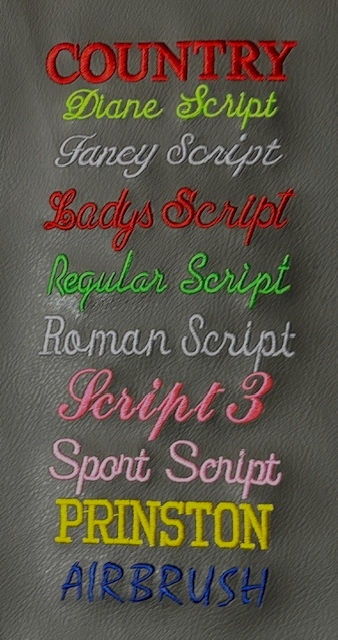The Art of Custom Embroidery: Unlocking the Secrets to Creating One-of-a-kind and Remarkable Layouts
Embroidery, a craft steeped in tradition and virtuosity, holds within its intricate stitches the power to transform fabric into a canvas of distinct expression. The keys to creating custom embroidery styles that captivate the eye and leave a lasting impact hinge on a fragile equilibrium of technique, creative thinking, and focus to information. As we dive right into the globe of personalized needlework, we discover the nuanced interplay in between thread option, sew intricacy, and style customization that raises a simple garment to an artwork. Join us on a journey with the art of customized embroidery as we decipher the mysteries behind crafting truly memorable and distinctive developments.
Choosing the Right Needlework Threads
When picking embroidery strings, what vital aspects should you consider to guarantee the most effective results for your customized styles? The choice of needlework string is crucial in identifying the final result of your stitched style. Among the primary factors to consider is the product of the thread. Different materials such as cotton, polyester, rayon, and silk offer differing levels of shine, sturdiness, and structure. It is important to choose a thread product that matches the material you are stitching on and straightens with the desired look of the layout.
Moreover, the weight or density of the string plays a substantial role in the look of the embroidery. Thicker strings can add dimension and texture to your design, while finer strings are ideal for complex information and tiny text. In addition, considering the shade fastness and washability of the string is vital to guarantee that your custom styles keep their top quality and vibrancy in time. By meticulously reviewing these factors and choosing high-grade strings that satisfy your details demands, you can improve the aesthetic allure and durability of your stitched developments.
Discovering Different Stitch Methods
To look into the world of 'Discovering Various Stitch Techniques', one have to comprehend the intricacies and nuances that each sewing approach offers the art of needlework. Various stitch techniques not only include aesthetic passion however also add to the overall structure and dimension of the style. One prominent stitch technique is the satin stitch, which involves carefully packed parallel stitches to create a smooth and glossy surface area, suitable for completing forms and creating strong outlines.
On the various other hand, the backstitch is a flexible strategy typically used for outlining and including fine information. It entails sewing backwards to produce a solid line of embroidery. Additionally, the French knot stitch adds a tactile element to designs, ideal for developing textured accents like blossom centers or ornamental touches.
Exploring different stitch techniques allows embroiderers to have fun with light, shadow, and deepness within their layouts, raising the visual charm and artistic top quality of their needlework projects. By mastering numerous stitching techniques, one can open unlimited possibilities for producing special and remarkable personalized needlework items.
Incorporating Personalized Design Elements
Having actually discovered the intricacies of various stitch techniques such as the satin stitch, backstitch, and French knot, the focus now shifts towards incorporating individualized style aspects in customized embroidery tasks. Individualized layout aspects play a vital function in making needlework jobs truly unique and unforgettable. One method to include customization is by adding initials, names, or considerable days to the style. This not only includes a personalized touch but also enhances the nostalgic worth of the embroidery item.
One more method to include customized style components is by including icons or themes that hold unique meaning to the recipient or mirror their passions and individuality. Incorporating a preferred blossom, animal, or hobby-related sign can make the needlework design a lot more meaningful and individualized. Furthermore, picking shades that resonate with the recipient or line up with the desired style can even more improve the customization of the embroidery job.
Understanding the Art of Shade Sychronisation
One key element of color sychronisation is recognizing color concept. This consists of knowing exactly how various colors engage with each various other, the feelings they convey, and exactly how they can be incorporated to create aesthetically appealing designs. By using color theory concepts, embroiderers can develop unified shade schemes that improve the overall look of the layout.
Additionally, paying interest to comparison is essential in color sychronisation. Making use of contrasting shades can help certain aspects of the layout pop, boost getting fitted for a suit legibility, and develop a visually vibrant needlework piece. By mastering the art of color sychronisation, embroiderers can boost their layouts and develop memorable pieces that resonate with clients and customers alike.
Enhancing Texture With Advanced Embroidery Stitches

French knots, for instance, are perfect for including small, raised dots to your layout, resembling the look of beads or creating a textured surface. Bullion knots, on the other hand, can be used to develop twisted, ropelike components that include an extravagant feeling to the needlework. Seed stitching entails little, scattered stitches that can fill out locations with a polychromatic texture, while turkey work produces cosy, dimensional accents reminiscent of pet hair or vegetation. Explore these advanced needlework stitches allows you to press the boundaries of standard needlework and create really special and visually attractive textures in click this link your styles.
Verdict
To conclude, the art of custom-made embroidery involves a mix of selecting the right strings, checking out various stitch strategies, integrating customized design elements, grasping shade sychronisation, and enhancing appearance with sophisticated stitches. By understanding and applying these crucial elements, embroiderers can create special and memorable layouts that showcase their creativity and skill. Needlework enthusiasts can open the secrets to developing stunning and custom items that stand out and leave a long-term impression.